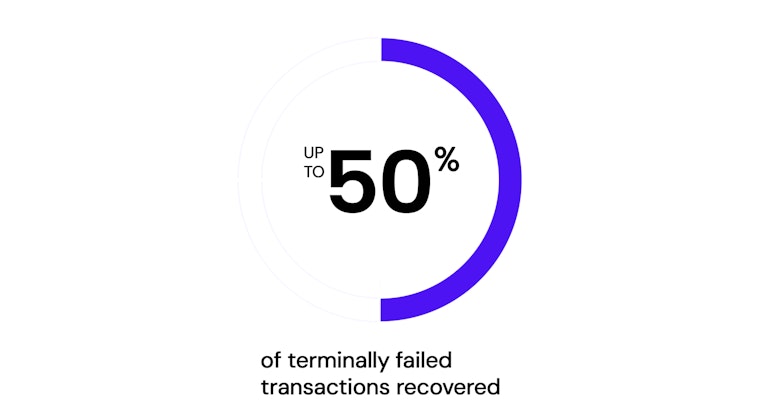Revenue recovery guide to resolve failed credit card transactions for subscription and recurring revenue businesses
Discover effective revenue recovery strategies for failed credit and debit card payment transactions. Understand how the credit card approval process works, explore the most common reasons transactions fail, and learn proven methods to resolve them. This guide is designed to help subscription and recurring revenue businesses recover failed transactions, reduce churn, and protect ongoing revenue streams.

In this guide we'll explore:
1] What is revenue recovery?2] Why is revenue recovery important?3] What is a failed credit or debit card transaction?4] Do failed payments affect more than just lost revenue?5] Why do card transactions fail?6] Who approves or declines credit card transactions?7] How does the credit card approval or decline process work?8] How can subscription businesses recover failed transactions?9] What are the best practices to improve the payment retry process?10] How to calculate the ROI of recovering failed payment transactions?What is revenue recovery?
Revenue recovery is a payments strategy used by subscription and recurring revenue businesses to recover money from failed or declined credit and debit card transactions. When a payment is declined, the business not only loses the immediate revenue from that transaction but also risks losing future recurring revenue if the subscriber churns. By focusing on revenue recovery, businesses can reduce involuntary churn and improve average customer lifetime value (ACLV).
Why is revenue recovery important?
To be successful and ensure ongoing revenue flow, subscription and other recurring revenue businesses must adopt strong revenue recovery strategies. Failed credit and debit card payments should be resolved quickly—before customers lose access to the product or service and decide to cancel. Effective revenue recovery is essential to reducing involuntary churn and is a key part of customer retention management.
What is a failed credit or debit card transaction?
For subscription businesses, customers typically assign a credit or debit card to their account to automatically pay subscription fees at renewal. While cards are generally reliable and secure for recurring payments, a failed transaction can disrupt the flow of recurring revenue.
Credit and debit card declines can occur for many reasons—such as expired cards, insufficient funds, or errors in payment details. Each declined transaction not only interrupts the customer’s service but also risks weakening the relationship between the subscriber and the business. In many cases, a simple payment error can lead to involuntary churn, requiring extra effort and resources to win the customer back.
Do failed payments affect more than just lost revenue?
Failed credit and debit card payments are not only a financial issue but also a customer experience and brand loyalty challenge. Subscribers expect frictionless digital experiences and rarely want to think about payments—especially failed ones that disrupt access and cause frustration. Some may even worry about credit impacts, further damaging trust in the service. If these issues persist, subscribers may cancel and switch to alternatives.
Today’s consumers expect seamless, reliable, and secure e-commerce experiences. Beyond value for money, they want to feel safe, appreciated, and supported. When payment failures interrupt that experience, it creates unnecessary friction that can erode trust and increase churn.
Why do card transactions fail?
Card transactions can fail for a variety of reasons. Below are five of the most common causes of failed credit and debit card payments that lead to revenue loss and potential subscriber churn:
- Outdated Credit Card: Banks regularly issue new cards—whether due to expiration, security updates, or customer requests. Subscribers often forget to update their payment details across all services, resulting in declined transactions and sudden service interruptions.
- Insufficient Funds: If a cardholder’s account lacks enough funds, the subscription charge may fail. This can happen because of low balances, account changes, or direct deposits being routed elsewhere. Importantly, it does not always mean the subscriber can no longer afford the service.
- Incorrect Card Details: Simple errors like entering the wrong card number, billing address, or ZIP code can prevent payments from going through. This is especially common after free trials, leaving businesses unable to collect recurring payments when the trial ends.
- Canceled or Inactive Card: Cards may be canceled due to theft, fraud, delinquency, or inactivity. Similarly, a newly issued card must be activated before use; if subscribers skip activation, transactions will be declined.
- Suspicious or Flagged Transactions: Card issuers monitor unusual activity to prevent fraud. Transactions may be declined if they appear suspicious—for example, large purchases after smaller test charges, transactions outside the customer’s usual location, or multiple quick charges in a short timeframe.
Who approves or declines credit card transactions?
Each credit or debit card transaction involves several parties as payment data moves through the approval network. The key players in the credit card approval ecosystem include:
- Customer / Cardholder: The subscriber who uses a credit or debit card to pay for recurring services.
- Merchant: The subscription business that provides the service and receives recurring payments from the customer.
- Merchant of Record: A third party that takes on the responsibility of accepting payments on behalf of a merchant that is not equipped to handle the complexities of card payment processing.
- Payment Gateway: The technology that securely transfers customer payment details from the merchant to the payment processor or acquiring bank.
- Payment Processor: Serves as the middle layer between the merchant and the acquiring bank, and sometimes also performs the gateway function.
- Credit Card Associations: Networks like Visa and Mastercard that set the rules governing card transactions and facilitate communication between banks.
- Issuing Bank: The bank or financial institution that issues credit or debit cards to consumers.
- Acquiring Bank: The bank where the merchant holds their merchant account, enabling them to accept card payments.

How does the credit card approval or decline process work?
The flow of a credit or debit card payment involves multiple steps across the card approval ecosystem:
- Customer Order: The customer places an order on the merchant’s website or application. Payment details (such as card number and expiration date) are entered and submitted.
- Payment Gateway: The gateway securely captures the payment data and transfers it to the payment processor through encrypted channels.
- Payment Processor: The processor manages the transaction and forwards the card and payment details to the credit card association network.
- Credit Card Association: Networks such as Visa or Mastercard send the transaction request to the customer’s issuing bank for approval or decline.
- Issuing Bank Decision: The issuing bank reviews the request and either approves or denies the transaction. It then relays the decision back through the credit card association to the payment processor.
- Processor Response: The payment processor delivers the approval or denial code to the merchant.
- Funds Transfer: If approved, funds are released by the issuing bank to the payment processor. The processor transfers the money to the acquiring bank.
- Merchant Settlement: Finally, the acquiring bank deposits the funds into the merchant’s account.

How can subscription businesses recover failed transactions?
When a credit or debit card payment is declined, subscription businesses can take several steps to recover the failed payment and prevent subscriber churn:
- Basic Retry Logic: Businesses often resubmit failed transactions after a delay. Many subscription platforms include automatic retries, but strategies are often blind to the cause of failure or card issuer guidelines. For example, some platforms retry daily until month-end, while others retry weekly. A smarter approach is to use data-driven services that optimize retry timing and logic for higher success rates.
- Account Updating: Account updater services can provide updated card details, such as replacements for expired cards, to improve transaction success. However, updates can take several days to process. Businesses that cancel service too quickly may lose subscribers unnecessarily. Timing and proper use of updater services are critical.
- Dedicated “Saves” Teams: Some companies establish customer support teams to manually resolve payment issues. While this can work for high-value subscriptions, it is often costly and may create awkward interactions with customers. Notifying subscribers about payment failures should be handled carefully to avoid damaging long-term relationships.
What are the best practices to improve the payment retry process?
Recovering failed payments through retries requires strategy, experimentation, and ongoing analysis. Below are proven best practices to optimize retry success:
- Study Retry Patterns: Avoid “blind” retry logic. Instead, analyze both successful and failed attempts to identify trends. Review credit card issuer error codes, track what works, and revisit results regularly. Continuous analysis helps maximize recovery while staying within issuer guidelines.
- Experiment with Timing: Test different days of the week and times of the month for retries. For example, avoid running retries just before common payday cycles. Each customer base is unique, so experimenting with timing can uncover patterns that improve results.
- Know When to Push Further: While over-retrying can raise red flags with issuers or processors, there are situations where additional attempts pay off. Use insights from error codes and historical performance to decide when it makes sense to exceed standard retry recommendations.
- Bring in Experts: Once internal strategies reach their limit, consider working with specialized payment recovery providers. Their data-driven expertise can deliver higher recovery rates and protect recurring revenue streams.
How to calculate the ROI of recovering failed payment transactions?
Even small improvements in payment recovery can make a significant impact on recurring revenue. For example, increasing the monthly customer retention rate by just 5% can expand your subscriber base by more than 40% over 24 months.
To measure this impact, track key subscription metrics such as churn rate and subscriber ROI (sROI). These metrics reveal how effective your payment recovery efforts are in retaining customers and protecting long-term revenue.
Example: If your business loses $20,000 each month due to failed transactions, recovering just half of that amount adds back $10,000 in recurring revenue. Over a year, that recovery translates into $120,000 in additional revenue, not including the extended lifetime value of subscribers who remain active.
Use our Retention ROI Calculator to explore how incremental gains in failed payment recovery and customer retention can generate substantial growth over time.
Recover Failed Payments and Reduce Churn with Vindicia Retain
At Vindicia, our retention and payments experts work closely with subscription businesses to address the unique challenges of failed transactions and customer churn. The key to long-term success is understanding the root causes of payment failures and applying data-driven solutions to protect recurring revenue streams.

Vindicia Retain automatically evaluates failed payment transactions and applies machine learning–driven subscription intelligence to optimize recovery. By working seamlessly with existing billing platforms and payment processors, Retain can recover up to 50% of previously failed transactions—keeping revenue flowing and subscribers connected.
With Vindicia Retain, recovery happens in the background. Customers experience uninterrupted service without the frustration of declined payments, intrusive emails, or unnecessary phone calls. The result is higher retention, stronger customer lifetime value, and improved recurring revenue.
Book a demo
See for yourself why Vindicia Retain is the leading solution for recovering failed payment transactions. Our team will show you how Retain helps subscription businesses reduce churn, protect recurring revenue, and accelerate growth.